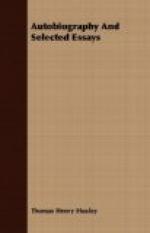Again, think of the microscopic fungus—a mere infinitesimal ovoid particle, which finds space and duration enough to multiply into countless millions in the body of a living fly; and then of the wealth of foliage, the luxuriance of flower and fruit, which lies between this bald sketch of a plant and the giant pine of California, towering to the dimensions of a cathedral spire, or the Indian fig, which covers acres with its profound shadow, and endures while nations and empires come and go around its vast circumference. Or, turning to the other half of the world of life, picture to yourselves the great Finner whale,[93] hugest of beasts that live, or have lived, disporting his eighty or ninety feet of bone, muscle and blubber, with easy roll, among waves in which the stoutest ship that ever left dockyard would flounder hopelessly; and contrast him with the invisible animalcules—mere gelatinous specks, multitudes of which could, in fact, dance upon the point of a needle with the same ease as the angels of the Schoolmen could, in imagination. With these images before your minds, you may well ask, what community of form, or structure, is there between the animalcule and the whale; or between the fungus and the fig-tree? And, a fortiori,[94] between all four?
Finally, if we regard substance, or material composition, what hidden bond can connect the flower which a girl wears in her hair and the blood which courses through her youthful veins; or, what is there in common between the dense and resisting mass of the oak, or the strong fabric of the tortoise, and those broad disks of glassy jelly which may be seen pulsating through the waters of a calm sea, but which drain away to mere films in the hand which raises them out of their element?
Such objections as these must, I think, arise in the mind of every one who ponders, for the first time, upon the conception of a single physical basis of life underlying all the diversities of vital existence; but I propose to demonstrate to you that, notwithstanding these apparent difficulties, a threefold unity—namely, a unity of power or faculty, a unity of form, and a unity of substantial composition—does pervade the whole living world.
No very abstruse argumentation is needed, in the first place to prove that the powers, or faculties, of all kinds of living matter, diverse as they may be in degree, are substantially similar in kind.
Goethe has condensed a survey of all powers of mankind into the well-known epigram:—[95]
“Warum treibt sich das Volk so und schreit? Es will sich ernahren Kinder zeugen, und die nahren so gut es vermag. . . . . . . . . . . . . . Weiter bringt es kein Mensch, stell’ er sich wie er auch will.”
In physiological language this means, that all the multifarious and complicated activities of man are comprehensible under three categories. Either they are immediately directed towards the maintenance and development of the body, or they effect transitory




